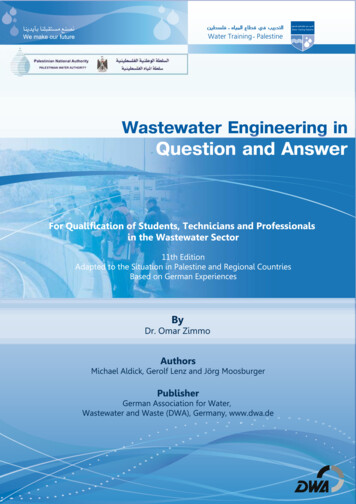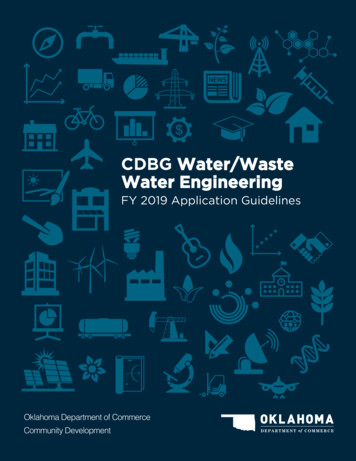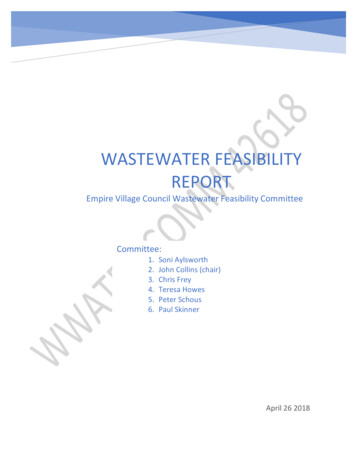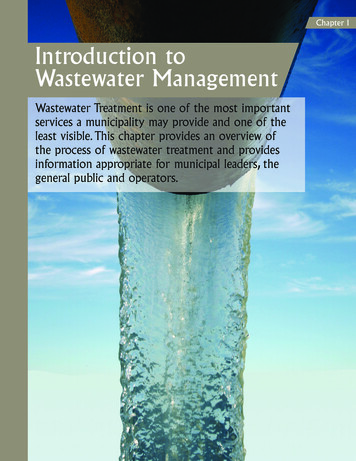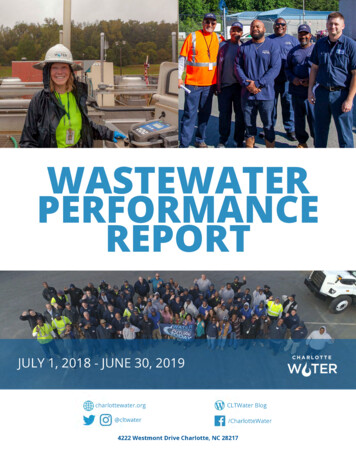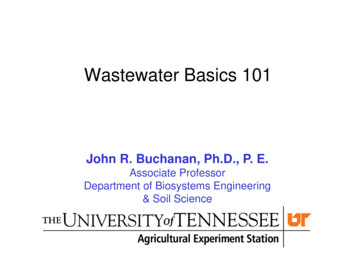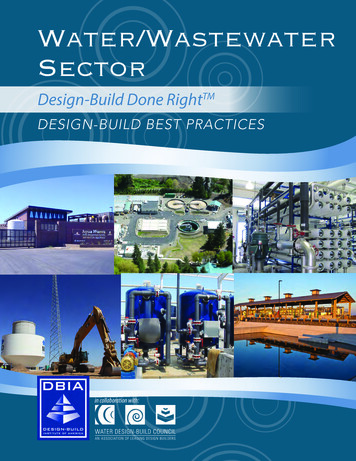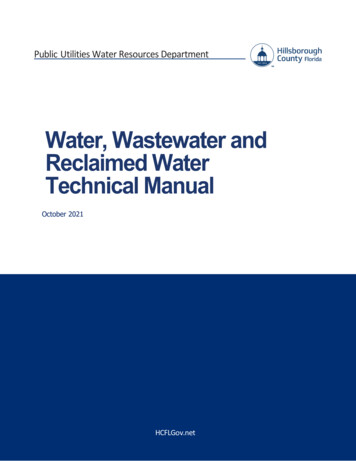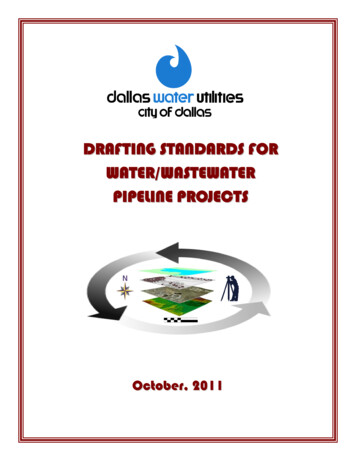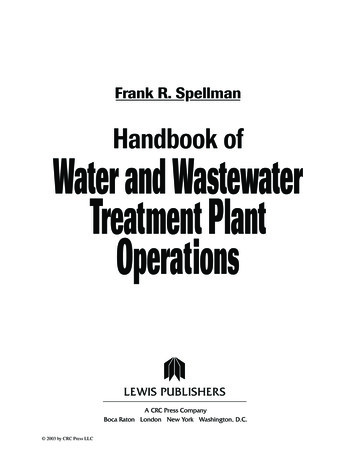
Transcription
Frank R. SpellmanHandbook ofWater and WastewaterTreatment PlantOperationsLEWIS PUBLISHERSA CRC Press CompanyBoca Raton London New York Washington, D.C. 2003 by CRC Press LLC
Library of Congress Cataloging-in-Publication DataSpellman, Frank R.Handbook of water & wastewater treatment plant operations / by Frank R. Spellman.p. cm.Includes bibliographical references and index.ISBN 1-56670-627-0 (alk. paper)1. Water—treatment plants—Handbooks, manuals, etc. 2. Sewage disposalplants—Handbooks, manuals, etc. 3. Water—PuriÞcation—Handbooks, manuals, etc. 4.Sewage—PuriÞcation—Handbooks, manuals, etc. I. Title: Handbook of water andwastewater treatment plant operations. II. Title.TD434.S64 2003628.1 62—dc212003040119This book contains information obtained from authentic and highly regarded sources. Reprinted material is quoted with permission, and sources areindicated. A wide variety of references are listed. Reasonable efforts have been made to publish reliable data and information, but the author and thepublisher cannot assume responsibility for the validity of all materials or for the consequences of their use.Neither this book nor any part may be reproduced or transmitted in any form or by any means, electronic or mechanical, including photocopying,microÞlming, and recording, or by any information storage or retrieval system, without prior permission in writing from the publisher.The consent of CRC Press LLC does not extend to copying for general distribution, for promotion, for creating new works, or for resale. SpeciÞcpermission must be obtained in writing from CRC Press LLC for such copying.Direct all inquiries to CRC Press LLC, 2000 N.W. Corporate Blvd., Boca Raton, Florida 33431.Trademark Notice: Product or corporate names may be trademarks or registered trademarks, and are used only for identiÞcation and explanation,without intent to infringe.Visit the CRC Press Web site at www.crcpress.com 2003 by CRC Press LLCLewis Publishers is an imprint of CRC Press LLCNo claim to original U.S. Government worksInternational Standard Book Number 1-56670-627-0Library of Congress Card Number 2003040119Printed in the United States of America 1 2 3 4 5 6 7 8 9 0Printed on acid-free paper 2003 by CRC Press LLC
PrefaceWater does not divide; it connects. With simplicity it linksall aspects of our existence.David Rothenberg and Marta UlvaenusIn Handbook of Water and Wastewater Treatment PlantOperations, the intent of the author is twofold. The Þrstintent is to consolidate the information and experience inwaterworks and wastewater treatment plant operationsthat have evolved as a result of technological advances inthe Þeld, and as a result of the concepts and policiespromulgated by the environmental laws and the subsequent guidelines. The second intent is to discuss step-bystep procedures for the correct and efÞcient operation ofwater and wastewater treatment systems. Tertiary to thistwofold intent is the proper preparation of operators toqualify for state licensure and certiÞcation examinations.With the impetus given to water quality improvementthrough the Municipal Construction Grants Program, theUnited States has undertaken an unprecedented buildingprogram for new and improved water and wastewater treatment systems. To date, much emphasis has been placed ontraining engineers to plan, design, and construct treatmentfacilities. At present, many programs in various engineering disciplines at many universities offer courses in waterand wastewater treatment plant design and operation.This text is not about the planning, designing, or construction of water and wastewater treatment facilities.While these tasks are paramount to conception and construction of needed facilities and needed infrastructure,many excellent texts are available that cover these important areas. This text is not about engineering at all. Instead,it is about operations and is designed for the operator. Weoften forget the old axiom: someone must build it, butonce built, someone must operate it. It is the operation of“it” that concerns us here.Several excellent texts have been written on water andwastewater treatment plant operations. Thus, the logicalquestion is, why a new text covering a well-trodden road?The compound answer is a text that is comprehensivein scope, current, and deals with real world problemsinvolved with plant operations is needed. The simpleanswer is that after September 11, things have changed.Many of these changes were apparent before September 11; at the same time, many of our present needs werenot so apparent. Consider, for example, the need for plantsto become more efÞcient in operation and more economicalin practice. This is not new, but it now takes on addedimportance because of the threat of privatization. We cover 2003 by CRC Press LLCprivatization and the benchmarking process in this text.On the other hand, how many of us thought security wasa big deal prior to September 11? Some of us did, whilesome of us did not give it any thought at all. Today, thingsare different; we must adjust or fall behind. In the presentclimate, falling behind on the security of our potable watersupplies is not an option. We must aggressively protectour precious water sources and those ancillaries that arecritical to maintaining and protecting water quality. Wecover plant security concerns in this text.There are other current issues. For example, arsenicin drinking water received a lot of coverage in the pressrecently. We all know that arsenic is a deadly poison,depending on dose, of course. Headlines stating thatarsenic has been found in certain municipal drinking watersupplies are a red ßag issue to many people. But is it reallyan issue? We cover arsenic in drinking water in this text.Another red ßag issue that has received some pressand the attention of regulators is the presence of pathogenic protozoans, such as Giardia and Cryptosporidium,in drinking water supplies. We cover both of these protozoans in this text.In wastewater treatment (as well as water treatment),a lot of attention has been focused on disinfection byproducts in water efßuents outfalled into receiving waterbodies. We cover disinfection by-products in this text.Water and wastewater treatment is about mitigatingthe problems mentioned above. However, treatment operations are about much more. To handle today’s problems,water and wastewater treatment system operators must begeneralists. Herein lies the problem. Many of the textspresently available for water and wastewater operator useare limited in scope and narrowly focused in content. Mostof these texts take a bare bones approach to presentation.That is, the basics of each unit process are usually adequately covered, but this is the extent of the coverage.At present, available texts either ignore, avoid, or paycursory attention to such important areas as the multiplebarrier concept, maintaining infrastructure, benchmarking,plant security, operator roles, water hydraulics, microbiology, water ecology, basic electrical principles, pumping,conveyance, ßow measurement, basic water chemistry,water quality issues, biomonitoring, sampling and testing,water sources, and watershed protection. All of theseimportant topics are thoroughly discussed in Handbook ofWater and Wastewater Treatment Plant Operations.Though directed at water and wastewater operators,this book will serve the needs of students; teachers; con-
sulting engineers; and technical personnel in city, state,and federal organizations who must review operations andoperating procedures. In order to maximize the usefulnessof the material contained in the test, it has been presentedin plain English in a simpliÞed and concise format. Manytables have been developed, using a variety of sources.To assure correlation to modern practice and design,illustrative problems are presented in terms of commonlyused operational parameters.Each chapter ends with a chapter review test to helpevaluate mastery of the concepts presented. Before goingon to the next chapter, take the review test, compare youranswers to the key provided in Appendix A, and review 2003 by CRC Press LLCthe pertinent information for any problems you missed. Ifyou miss many items, review the whole chapter.The indented notes displayed in various locationsthroughout this text indicate or emphasize importantpoints to study carefully.This text is accessible to those who have no experiencewith water and wastewater operations. If you workthrough the text systematically, you can acquire an understanding of and skill in water and wastewater operations.This will add a critical component to your professionalknowledge.Frank R. SpellmanNorfolk, VA
ContentsPART IWater and Wastewater Operations: An OverviewChapter 1Problems Facing Water and Wastewater Treatment Operations1.11.2IntroductionThe Paradigm Shift1.2.1A Change in the Way Things are Understood and Done1.3Multiple-Barrier Concept1.3.1Multiple-Barrier Approach: Wastewater Operations1.4Management Problems Facing Water and Wastewater Operations1.4.1Compliance with New, Changing, and Existing Regulations1.4.2Maintaining Infrastructure1.4.3Privatizing and/or Reengineering1.4.4Benchmarking1.4.4.1Benchmarking: The Process1.4.5The Bottom Line on Privatization1.5Upgrading Security1.5.1The Bottom Line on Security1.6Technical Management vs. Professional Management1.7Chapter Review Questions and ProblemsReferencesChapter 2Water and Wastewater Operators and Their Roles2.12.2Water and Wastewater OperatorsSetting the Record Straight2.2.1The Computer-Literate Jack2.2.2Plant Operators as Emergency Responders2.2.3Operator Duties, Numbers, and Working Conditions2.3Operator CertiÞcation/Licensure2.4Chapter Review Questions and ProblemsReferencesChapter 3Water and Wastewater References, Models, and Terminology3.13.23.3Setting the StageTreatment Process ModelsKey Terms Used in Waterworks and Wastewater Operations3.3.1Terminology and DeÞnitions3.4Chapter Review Question and ProblemsReferences 2003 by CRC Press LLC
PART IIChapter 154.164.17Water/Wastewater Operations: Math and Technical AspectsWater and Wastewater Math OperationsIntroductionCalculation StepsTable of Equivalents, Formulae, and SymbolsTypical Water and Wastewater Math Operations4.4.1Arithmetic Average (or Arithmetic Mean) and Median4.4.2Ratio4.4.3Percent4.4.3.1Practical Percentage Calculations4.4.4Units and Conversions4.4.4.1Temperature Conversions4.4.4.2Milligrams per Liter (Parts per Million)Measurements: Areas and Volumes4.5.1Area of a Rectangle4.5.2Area of a Circle4.5.3Area of a Circular or Cylindrical Tank4.5.4Volume Calculations4.5.4.1Volume of Rectangular Tank4.5.4.2Volume of a Circular or Cylindrical Tank4.5.4.3Example Volume ProblemsForce, Pressure, and HeadFlow4.7.1Flow Calculations4.7.1.1Instantaneous Flow Rates4.7.1.2Flow through a Full Pipeline4.7.2Velocity Calculations4.7.3Average Flow Rate Calculations4.7.4Flow Conversion CalculationsDetention Time4.8.1Hydraulic Detention Time4.8.1.1Detention Time in Days4.8.1.2Detention Time in Hours4.8.1.3Detention Time in MinutesChemical Dosage Calculations4.9.1Chlorine Dosage4.9.2Hypochlorite DosagePercent RemovalPopulation Equivalent or Unit Loading FactorSpeciÞc GravityPercent Volatile Matter Reduction in SludgeHorsepower4.14.1 Water Horsepower4.14.2 Brake Horsepower4.14.3 Motor HorsepowerElectrical PowerChemical Coagulation and Sedimentation4.16.1 Calculating Feed Rate4.16.2 Calculating Solution StrengthFiltration4.17.1 Calculating the Rate of Filtration4.17.2 Filter Backwash 2003 by CRC Press LLC
4.18Practical Water Distribution System Calculations4.18.1 Water Flow Velocity4.18.2 Storage Tank Calculations4.18.3 Distribution System Disinfection Calculations4.19 Complex Conversions4.19.1 Concentration to Quantity4.19.1.1 Concentration (Milligrams per Liter) to Pounds4.19.1.2 Concentration (Milligrams per Liter) to Pounds/Day4.19.1.3 Concentration (Milligrams per Liter) to Kilograms per Day4.19.1.4 Concentration (milligrams/kilogram) to pounds/ton4.19.2 Quantity to Concentration4.19.2.1 Pounds to Concentration (Milligrams per Liter)4.19.2.2 Pounds per Day to Concentration (Milligrams per Liter)4.19.2.3 Kilograms per Day to Concentration (Milligrams per Liter)4.19.3 Quantity to Volume or Flow Rate4.19.3.1 Pounds to Tank Volume (Million Gallons)4.19.3.2 Pounds per Day to Flow (Million Gallons per Day)4.19.3.3 Kilograms per Day to Flow (Million Gallons per Day)4.20 Chapter Review Questions and ProblemsReferenceChapter 55.15.25.35.45.55.65.75.85.9Water HydraulicsWhat is Water Hydraulics?Basic Concepts5.2.1Stevin’s LawProperties of Water5.3.1Density and SpeciÞc GravityForce and Pressure5.4.1Hydrostatic Pressure5.4.2Effects of Water under PressureHead5.5.1Static Head5.5.2Friction Head5.5.3Velocity Head5.5.4Total Dynamic Head (Total System harge Rate: Water in ometric Surface and Bernoulli’s Theorem5.7.1Law of Conservation of Energy5.7.2Energy Head5.7.3Piezometric Surface5.7.3.1Head Loss5.7.3.2Hydraulic Grade Line5.7.4Bernoulli’s Theorem5.7.4.1Bernoulli’s EquationHydraulic Machines (Pumps)5.8.1Pumping HydraulicsWell and Wet Well Hydraulics5.9.1Well Hydraulics5.9.2Wet Well Hydraulics 2003 by CRC Press LLC
5.10Friction5.10.15.10.25.10.3Head LossFlow in PipelinesPipe and Open Flow BasicsMajor Head Loss5.10.3.1 Components of Major Head Loss5.10.3.2 Calculating Major Head Loss5.10.4 Minor Head Loss5.11 Basic Piping Hydraulics5.11.1 Piping Networks5.11.1.1 Energy Losses in Pipe Networks5.11.1.2 Pipes in Series5.11.1.3 Pipes in Parallel5.12 Open-Channel Flow5.12.1 Characteristics of Open-Channel Flow5.12.1.1 Laminar and Turbulent Flow5.12.1.2 Uniform and Varied Flow5.12.1.3 Critical Flow5.12.1.4 Parameters Used in Open-Channel Flow5.12.2 Open-Channel Flow Calculations5.12.3 Open-Channel Flow: The Bottom Line5.13 Flow Measurement5.13.1 Flow Measurement: The Old-Fashioned Way5.13.2 Basis of Traditional Flow Measurement5.13.3 Flow Measuring Devices5.13.3.1 Differential Pressure Flowmeters5.13.3.2 Magnetic Flowmeters5.13.3.3 Ultrasonic Flowmeters5.13.3.4 Velocity Flowmeters5.13.3.5 Positive-Displacement Flowmeters5.13.4 Open-Channel Flow Measurement5.13.4.1 Weirs5.13.4.2 Flumes5.14 Chapter Review Questions and ProblemsReferencesChapter 6Fundamentals of Electricity6.16.26.36.46.5Electricity: What Is It?Nature of ElectricityThe Structure of MatterConductors, Semiconductors, and InsulatorsStatic Electricity6.5.1Charged Bodies6.5.2Coulomb’s Law6.5.3Electrostatic Fields6.6Magnetism6.6.1Magnetic Materials6.6.2Magnetic Earth6.7Difference in Potential6.7.1The Water Analogy6.7.2Principal Methods of Producing Voltage6.8Current6.9Resistance6.10 Battery-Supplied Electricity 2003 by CRC Press LLC
6.196.20The Voltaic CellPrimary and Secondary CellsBattery6.10.3.1 Battery Operation6.10.3.2 Combining Cells6.10.4 Types of Batteries6.10.4.1 Dry Cell6.10.4.2 Lead-Acid Battery6.10.4.3 Alkaline Cell6.10.4.4 Nickel-Cadmium Cell6.10.4.5 Mercury Cell6.10.4.6 Battery CharacteristicsThe Simple Electrical Circuit6.11.1 Schematic RepresentationOhm’s lawElectrical Power6.13.1 Electrical Power CalculationsElectrical EnergySeries DC Circuit Characteristics6.15.1 Series Circuit Resistance6.15.2 Series Circuit Current6.15.3 Series Circuit Voltage6.15.4 Series Circuit Power6.15.5 Summary of the Rules for Series DC Circuits6.15.6 General Series Circuit Analysis6.15.6.1 Kirchhoff’s Voltage LawGroundOpen and Short CircuitsParallel DC Circuits6.18.1 Parallel Circuit Characteristics6.18.2 Voltage in Parallel Circuits6.18.3 Current in Parallel Circuits6.18.4 Parallel Circuits and Kirchhoff’s Current Law6.18.5 Parallel Circuit Resistance6.18.5.1 Reciprocal Method6.18.5.2 Product over the Sum Method6.18.5.3 Reduction to an Equivalent Circuit6.18.6 Power in Parallel Circuits6.18.7 Rules for Solving Parallel DC CircuitsSeries-Parallel Circuits6.19.1 Solving a Series-Parallel CircuitConductors6.20.1 Unit Size of Conductors6.20.1.1 Square Mil6.20.1.2 Circular Mil6.20.1.3 Circular-Mil-Foot6.20.1.4 Resistivity6.20.1.5 Wire Measurement6.20.2 Factors Governing the Selection of Wire Size6.20.2.1 Copper vs. Other Metal Conductors6.20.2.2 Temperature CoefÞcient6.20.3 Conductor Insulation6.20.4 Conductor Splices and Terminal Connections6.20.5 Soldering Operations 2003 by CRC Press LLC
6.216.226.236.246.256.20.6 Solderless Connections6.20.7 Insulation TapeElectromagnetism6.21.1 Magnetic Field around a Single Conductor6.21.2 Polarity of a Single Conductor6.21.3 Field around Two Parallel Conductors6.21.4 Magnetic Field of a Coil6.21.4.1 Polarity of an Electromagnetic Coil6.21.4.2 Strength of an Electromagnetic Field6.21.5 Magnetic Units6.21.6 Properties of Magnetic Materials6.21.6.1 Permeability6.21.6.2 Hysteresis6.21.7 ElectromagnetsAC Theory6.22.1 Basic AC Generator6.22.1.1 Cycle6.22.1.2 Frequency, Period, and Wavelength6.22.2 Characteristic Values of AC Voltage and Current6.22.2.1 Peak Amplitude6.22.2.2 Peak-to-Peak Amplitude6.22.2.3 Instantaneous Amplitude6.22.2.4 Effective or Root-Mean-Square Value6.22.2.5 Average Value6.22.3 Resistance in AC Circuits6.22.4 Phase RelationshipsInductance6.23.1 Self-Inductance6.23.2 Mutual Inductance6.23.3 Calculation of Total InductancePractical Electrical Applications6.24.1 Electrical Power Generation6.24.2 DC Generators6.24.3 AC Generators6.24.4 Motors6.24.4.1 DC Motors6.24.4.2 AC Motors6.24.5 Transformers6.24.6 Power Distribution System Protection6.24.6.1 Fuses6.24.6.2 Circuit Breakers6.24.6.3 Control DevicesChapter Review Questions and ProblemsChapter 77.17.27.37.4Hydraulic Machines: PumpsIntroductionArchimedes’ ScrewPumping Hydraulics7.3.1DeÞnitionsBasic Principles of Water Hydraulics7.4.1Weight of Air7.4.2Weight of Water7.4.3Weight of Water Related to the Weight of Air7.4.4Water at Rest 2003 by CRC Press LLC
7.4.57.4.67.57.67.77.87.97.107.11Gauge PressureWater in Motion7.4.6.1Discharge7.4.6.2The Law of Continuity7.4.7Pipe FrictionBasic Pumping Calculations7.5.1Pumping Rates7.5.2Calculating Head Loss7.5.3Calculating Head7.5.4Calculating Horsepower and EfÞciency7.5.4.1Hydraulic Horsepower7.5.4.2Pump EfÞciency and Brake Horsepower7.5.5SpeciÞc SpeedPump Characteristic Curves7.6.1Head-Capacity Curve7.6.2The Power-Capacity Curve7.6.3The EfÞciency-Capacity (E-Q) CurvePumps in Series and ParallelConsiderations for Pumping WastewaterTypes of Pumps Used in Water and Wastewater TreatmentIntroduction to Centrifugal Pumps7.10.1 Description7.10.2 Theory7.10.3 Types of Centrifugal Pumps7.10.3.1 Radial Flow Impeller Pumps7.10.3.2 Mixed Flow Impeller Pumps7.10.3.3 Axial Flow Impeller Pumps (Propeller Pump)7.10.4 Characteristics and Performance Curves7.10.4.1 Head-Capacity Curve7.10.4.2 EfÞciency Curve7.10.4.3 Brake Horsepower Curves7.10.5 Advantages and Disadvantages of a Centrifugal Pump7.10.5.1 Advantages7.10.5.2 Disadvantages7.10.6 Water and Wastewater ApplicationsCentrifugal Pump Components7.11.1 Casing7.11.1.1 Solid Casing7.11.1.2 Split Casings7.11.2 Impeller7.11.2.1 Semiopen Impeller7.11.2.2 Open Impeller7.11.2.3 Closed Impeller7.11.3 Wear Rings7.11.4 Shafts, Sleeves, and Couplings7.11.4.1 Shafting7.11.4.2 Sleeves7.11.4.3 Couplings7.11.5 StufÞng Box and Seals7.11.5.1 StufÞng Box or Packing Assembly7.11.5.2 Mechanical Seals7.11.6 Bearings7.11.6.1 Self-Aligning Double-Row Ball Bearing7.11.6.2 Single- or Double-Row Antifriction Ball Bearing7.11.6.3 Angular Contact Bearings 2003 by CRC Press LLC
7.127.137.147.157.167.11.6.4 Self-Aligning Spherical Roller Bearings7.11.6.5 Single-Row Tapered Roller Bearings7.11.6.6 Bearing Installation, Maintenance and LubricationCentrifugal Pump: Operational Procedures7.12.1 Installation7.12.2 Start-Up7.12.2.1 Start-Up Procedure7.12.3 Normal Operation7.12.4 Shutdown7.12.5 Priming7.12.5.1 Priming Procedure7.12.6 Backßushing7.12.6.1 Backßush Procedure7.12.7 Manual Removal ProcedureCentrifugal Pump: Maintenance Procedures7.13.1 Pump and Motor Lubrication7.13.2 Packing and Seal Replacement7.13.2.1 Packing Procedure7.13.2.2 Mechanical Seal Installation Procedure7.13.3 Pump and Motor Bearing Inspection7.13.4 Shaft and Coupling Alignment7.13.4.1 Alignment Procedure7.13.4.2 Removal of ObstructionsCentrifugal Pumps Preventive Maintenance7.14.1 Daily Maintenance7.14.2 Weekly Maintenance7.14.3 Monthly Maintenance7.14.4 Quarterly Maintenance7.14.5 Semiannual MaintenanceCentrifugal Pump Lubrication7.15.1 Purpose of Lubrication7.15.1.1 Separates Surfaces7.15.1.2 Prevents Wear7.15.1.3 Cushions Shock7.15.1.4 Transfers Heat7.15.1.5 Corrosion Protection7.15.1.6 Protective Seal7.15.2 Lubrication Requirements7.15.3 Lubrication Procedures7.15.3.1 Motor Bearing Lubrication7.15.3.2 Pump Bearing LubricationCentrifugal Pump: Troubleshooting7.16.1 The Troubleshooter7.16.2 Troubleshooting: What Is It?7.16.3 Goals of Troubleshooting7.16.4 The Troubleshooting Process7.16.5 Troubleshooting the Centrifugal Pump7.16.5.1 Pump Fails to Prime or Loses its Prime7.16.5.2 Pump Does Not Discharge7.16.5.3 Pump Does Not Deliver Rated Capacity7.16.5.4 Pump Does Not Deliver SufÞcient Pressure7.16.5.5 Pump Starts and Stops Pumping7.16.5.6 Pump Overloads Driver or Consumes Excessive Power7.16.5.7 Pump Is Noisy or Has Extensive Vibration7.16.5.8 Packing Has a Short Life 2003 by CRC Press LLC
7.16.5.9 Mechanical Seal Has a Short Life7.16.5.10 Mechanical Seal Leaks Excessively7.16.5.11 Bearings Have a Short Life7.16.5.12 Pump Overheats or Seizes7.17 Centrifugal Pump ModiÞcations7.17.1 Submersible Pumps7.17.1.1 Applications7.17.1.2 Advantages7.17.1.3 Disadvantages7.17.2 Recessed Impeller or Vortex Pumps7.17.2.1 Applications7.17.2.2 Advantages7.17.2.3 Disadvantages7.17.3 Turbine Pumps7.17.3.1 Application7.17.3.2 Advantages7.17.3.3 Disadvantages7.18 Positive-Displacement Pumps7.18.1 Reciprocating Pumps7.18.1.1 Diaphragm Pumps7.18.1.2 Metering Pumps7.18.1.3 Rotary Pumps7.18.1.4 Progressive-Cavity Pump7.18.1.5 Special Purpose Pumps7.19 Chapter Review Questions and ProblemsReferencesChapter 88.18.28.3Water and Wastewater ConveyanceDelivering the Lifeblood of CivilizationConveyance Systems8.2.1DeÞnitions8.2.2Fluids vs. Liquids8.2.3Maintaining Fluid Flow in Piping Systems8.2.3.1Scaling8.2.4Piping System Maintenance8.2.5Valves8.2.6Piping System Accessories8.2.7Piping Systems: Temperature Effects8.2.8Piping Systems: InsulationMetallic Piping8.3.1Piping Materials8.3.2Piping: The Basics8.3.2.1Pipe Sizes8.3.2.2Pipe Wall Thickness8.3.2.3Piping ClassiÞcation8.3.3Types of Piping Systems8.3.3.1Code for IdentiÞcation of Pipelines8.3.4Metallic Piping Materials8.3.4.1Characteristics of Metallic Materials8.3.5Maintenance Characteristics of Metallic Piping8.3.5.1Expansion and Flexibility8.3.5.2Pipe Support Systems8.3.5.3Valve Selection8.3.5.4Isolation 2003 by CRC Press LLC
8.48.58.68.78.88.3.5.5Preventing Backßow8.3.5.6Water Hammer8.3.5.7Air Binding8.3.5.8Corrosion Effects8.3.6Joining Metallic Pipe8.3.6.1Bell-and-Spigot Joints8.3.6.2Screwed or Threaded Joints8.3.6.3Flanged Joints8.3.6.4Welded Joints8.3.6.5Soldered and Brazed JointsNonmetallic Piping8.4.1Nonmetallic Piping Materials8.4.1.1Clay Pipe8.4.1.2Concrete Pipe8.4.1.3Plastic PipeTubing8.5.1Tubing vs. Piping: The Difference8.5.1.1Tubing8.5.2Advantages of Tubing8.5.2.1Tubing: Mechanical Advantages8.5.2.2Chemical Advantages8.5.3Connecting Tubing8.5.3.1Cutting Tubing8.5.3.2Soldering Tubing8.5.3.3Connecting Flared/Nonßared Joints8.5.4Bending Tubing8.5.5Types of Tubing8.5.5.1Typical Tubing ApplicationsIndustrial Hoses8.6.1Hose Nomenclature8.6.2Factors Governing Hose Selection8.6.3Standards, Codes, and Sizes8.6.3.1Hose Size8.6.4Hose ClassiÞcations8.6.4.1Nonmetallic Hoses8.6.4.2Metallic Hoses8.6.5Hose Couplings8.6.6Hose MaintenancePipe and Tube Fittings8.7.1Fittings8.7.2Functions of Fittings8.7.2.1Changing the Direction of Flow8.7.2.2Providing Branch Connections8.7.2.3Changing the Sizes of Lines8.7.2.4Sealing Lines8.7.2.5Connecting Lines8.7.3Types of Connections8.7.3.1Screwed Fittings8.7.3.2Flanged Connections8.7.3.3Connections8.7.4Tubing Fittings and ConnectionsValves8.8.1Valve Construction8.8.2Types of Valves 2003 by CRC Press LLC
8.8.2.1Ball Valves8.8.2.2Gate Valves8.8.2.3Globe Valves8.8.2.4Needle Valves8.8.2.5Butterßy Valves8.8.2.6Plug Valves8.8.2.7Check Valves8.8.2.8Quick-Opening Valves8.8.2.9Diaphragm Valves8.8.2.10 Regulating Valves8.8.2.11 Relief Valves8.8.2.12 Reducing Valves8.8.3Valve Operators8.8.3.1Pneumatic and Hydraulic Valve Operators8.8.3.2Magnetic Valve Operators8.8.4Valve Maintenance8.9Piping System: Protective 8.9.4Traps8.9.4.1Trap Maintenance and Testing8.10 Piping Ancillaries8.10.1 Gauges8.10.1.1 Pressure Gauges8.10.2 Vacuum Breakers8.10.3 Accumulators8.10.4 Air Receivers8.10.5 Heat Exchangers8.11 Chapter Review Questions and ProblemsReferencesChapter 9Flow Measurement9.19.2IntroductionMethods of Measuring Flow9.2.1Weirs9.2.2The Oscillating Disk Water Meter9.2.3Flumes9.2.4Venturi Meter9.2.5Magnetic Flowmeter9.3Flow Measurement Calculations9.3.1Calculation Method Used for Fill and Draw Technique9.3.2Calculation Method Used for Velocity/Area Technique9.3.3Calculation Method Used for V-Notch Weirs9.3.4Weir Overßow (Weir Loading Rate)9.3.5Calculation Method for Parshall Flume9.3.6Typical Flow Measurement Practice Calculations9.4Flow Measurement Operational Problems9.5Chapter Review Questions and ProblemsReferences 2003 by CRC Press LLC
Part IIICharacteristics of WaterChapter 10Basic Water Chemistry10.110.2IntroductionChemistry Concepts and DeÞnitions10.2.1 Concepts10.2.2 DeÞnitions10.3 Water Chemistry Fundamentals10.3.1 Matter10.3.1.1 The Content of Matter: The Elements10.3.2 Compound Substances10.4 The Water Molecule10.5 Water Solutions10.6 Water Constituents10.6.1 Solids10.6.2 Turbidity10.6.3 Color10.6.4 Dissolved Oxygen10.6.5 Metals10.6.6 Organic Matter10.6.7 Inorganic Matter10.6.7.1 Acids10.6.7.2 Bases10.6.7.3 Salts10.7 pH10.8 Alkalinity10.9 Hardness10.10 Water and Wastewater Chemicals and Chemical Processes10.10.1Odor Control (Wastewater Treatment)10.10.2Disinfection10.10.3Chemical .10.6Taste and Odor Removal10.10.7Water Softening10.10.8Recarbonation10.10.9Ion Exchange Softening10.10.10 Scaling and Corrosion Control10.11 Chapter Review Questions and ProblemsReferencesChapter 1111.111.211.3Water MicrobiologyIntroductionMicrobiology: What Is It?Water and Wastewater Microorganisms11.3.1Key Terms11.3.2Microorganisms (in 1.3.5The Cell11.3.5.1Structure of the Bacterial Cell 2003 by CRC Press LLC
11.4Bacteria11.4.1Bacterial Growth Factors11.4.2Destruction of Bacteria11.4.3Waterborne Bacteria11.5 Protozoa11.6 Microscopic Crustaceans11.7 Viruses11.8 Algae11.9 Fungi11.10 Nematodes and Flatworms (Worms)11.11 Pathogenic Protozoa and Helminths (Water)11.11.1Pathogenic Protozoa11.11.1.1 Giardia11.11.1.2 Cryptosporidium11.11.1.3 Cyclospora11.11.2Helminths11.12 Biological Aspects and Processes (Wastewater)11.12.1Aerobic Process11.12.2Anaerobic Process11.12.3Anoxic Process11.12.4Photosynthesis11.12.5Growth Cycles11.12.6Biogeochemical Cycles11.12.6.1 Carbon Cycle11.12.6.2 Nitrogen Cycle11.12.6.3 Sulfur Cycle11.12.6.4 Phosphorus Cycle11.13 Chapter Review Questions and ProblemsReferencesChapter 12Water Ecology12.112.212.3IntroductionSetting the StageEcology Terms12.3.1DeÞnition of Terms12.4 Levels of Organization12.5 Ecosystem12.6 Energy Flow in the Ecosystem12.7 Food Chain EfÞciency12.8 Ecological Pyramids12.9 Productivity12.10 Population Ecology12.11 Stream Genesis and Structure12.11.1 Water Flow in a Stream12.11.2 Stream Water Discharge12.11.3 Transport of Material12.11.4 Characteristics of Stream Channels12.11.5 Stream ProÞles12.11.6 Sinuosity12.11.7 Bars, Rifßes, and Pools12.11.8 The Floodplain12.11.9 Adaptations to Stream Current 2003 by CRC Press LLC
12.11.10 Types of Adaptive Changes12.11.11 SpeciÞc Adaptations12.12 Benthic Life: An Overview12.12.1 Benthic Plants and Animals12.13 Benthic Macroinvertebrates12.13.1 IdentiÞcation of Benthic Macroinvertebrates12.13.2 Macroinvertebrates and the Food Web12.13.3 Units of Organization12.13.4 Typical Running Water Benthic Macroinvertebrates12.14 Insect Macroinvertebrates12.14.1 Mayßies (Order: Ephemeroptera)12.14.2 Stoneßies (Order: Plecoptera)12.14.3 Caddisßies (Order: Trichoptera)12.14.4 True Flies (Order: Diptera)12.14.5 Beetles (Order: Coleoptera)12.14.6 Water Strider (Jesus bugs; Order: Hemiptera)12.14.7 Alderßies and Dobsonßies (Order: Megaloptera)12.14.8Dragonßies and Damselßies (Order: Odonata)12.15 Noninsect Macroinvertebrates12.15.1 Oligochaeta (Family: TuiÞcidae; Genus: Tubifex)12.15.2 Hirudinea (Leeches)12.14.3 Gastropoda (Lung-Breathing Snail)12.16 Chapter Review Questions and ProblemsReferencesChapter 1313.113.213.313.4Water QualityIntroductionThe Water CycleWater Quality Standards13.3.1Clean Water Act (1972)13.3.2Safe Drinking Water Act (1974)Water Quality Characteristics of Water and Wastewater13.4.1Physical Characteristics of Water and olor13.4.1.4Taste and Odor13.4.1.5Temperature13.4.2Chemical Characteristics of Water13.4.2.1Total Dissolved Solids ts13.4.3Chemical Characteristics of Wastewater13.4.3.1Organic Substances13.4.3.2Inorganic Substances13.4.4Biological Characteristics of Water and rotozoa13.4.4.4Worms (Helminths) 2003 by CRC Press LLC
13.5 Chapter Review Questions and ProblemsReferencesChapter 1414.114.214.314.4Biomonitoring, Monitoring, Sampling, and TestingWhat Is Biomonitoring?14.1.1Biotic Indices (Streams)14.1.1.1Benthic Macroinvertebrate Biotic IndexBiological Sampling (Streams)14.2.1Biological Sampling: Planni
Water and wastewater treatment is about mitigating the problems mentioned above. However, treatment oper-ations are about much more. To handle today s problems, water and wastewater treatment system operators must be generalists. Herein lies the problem. Many of the texts presently availab
